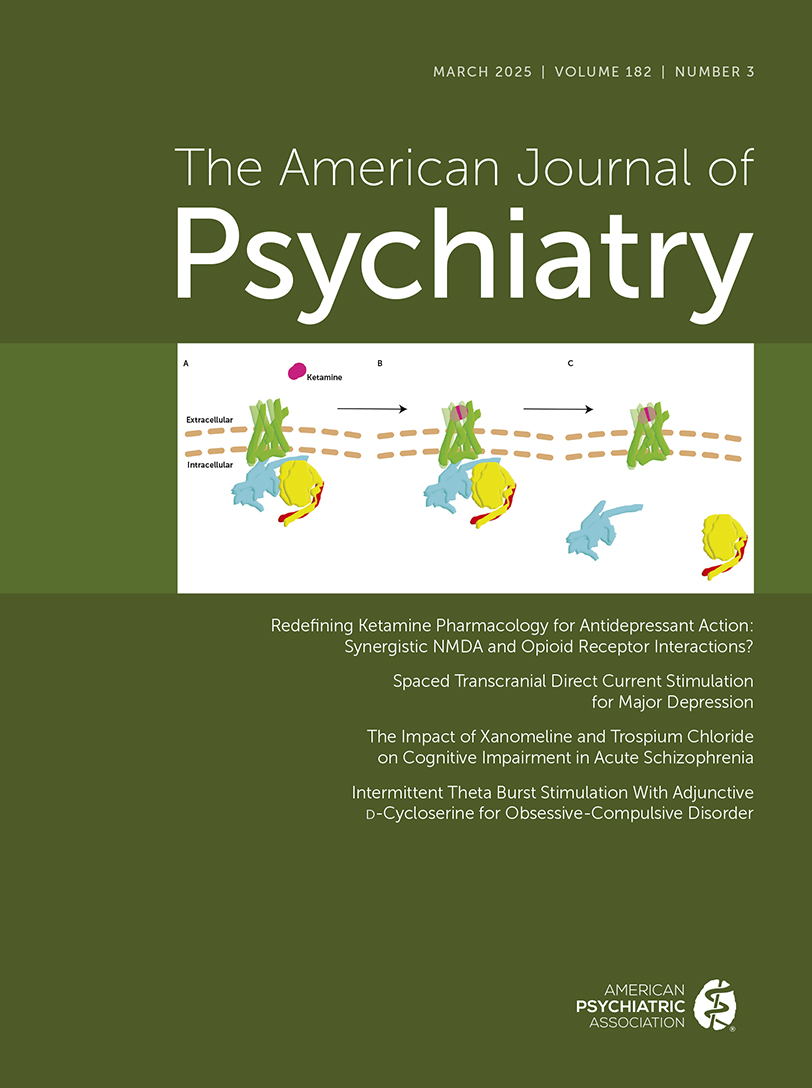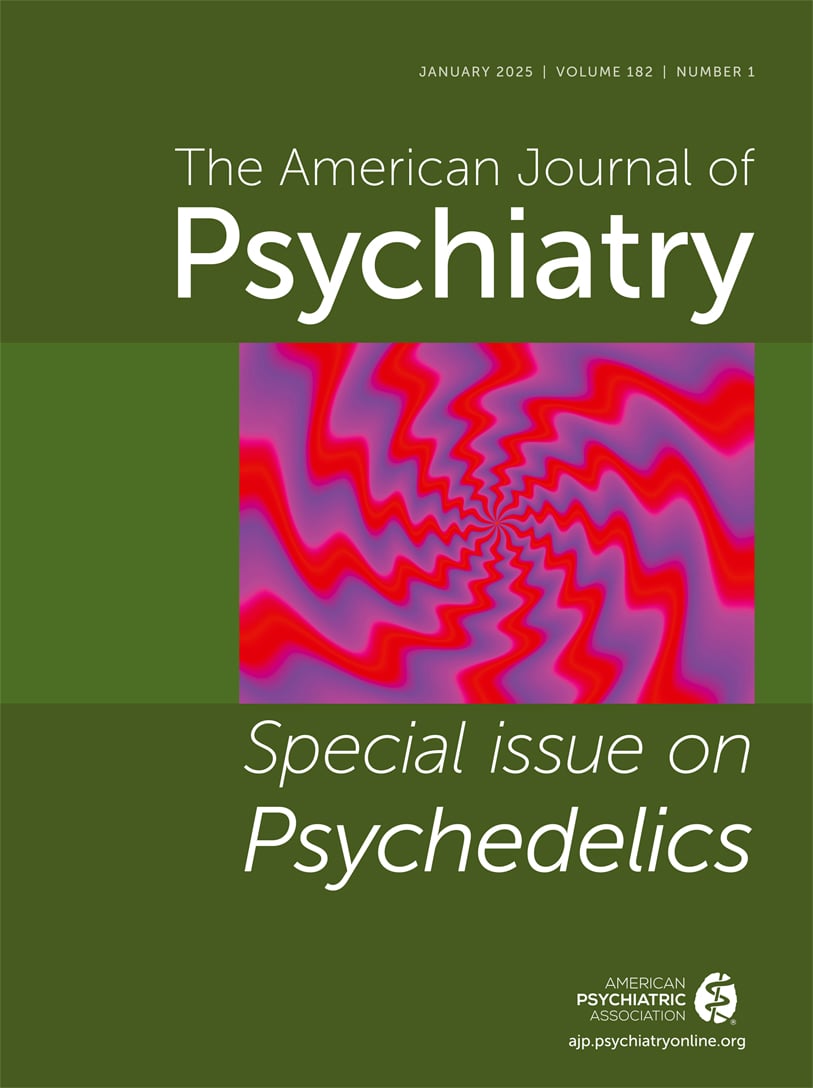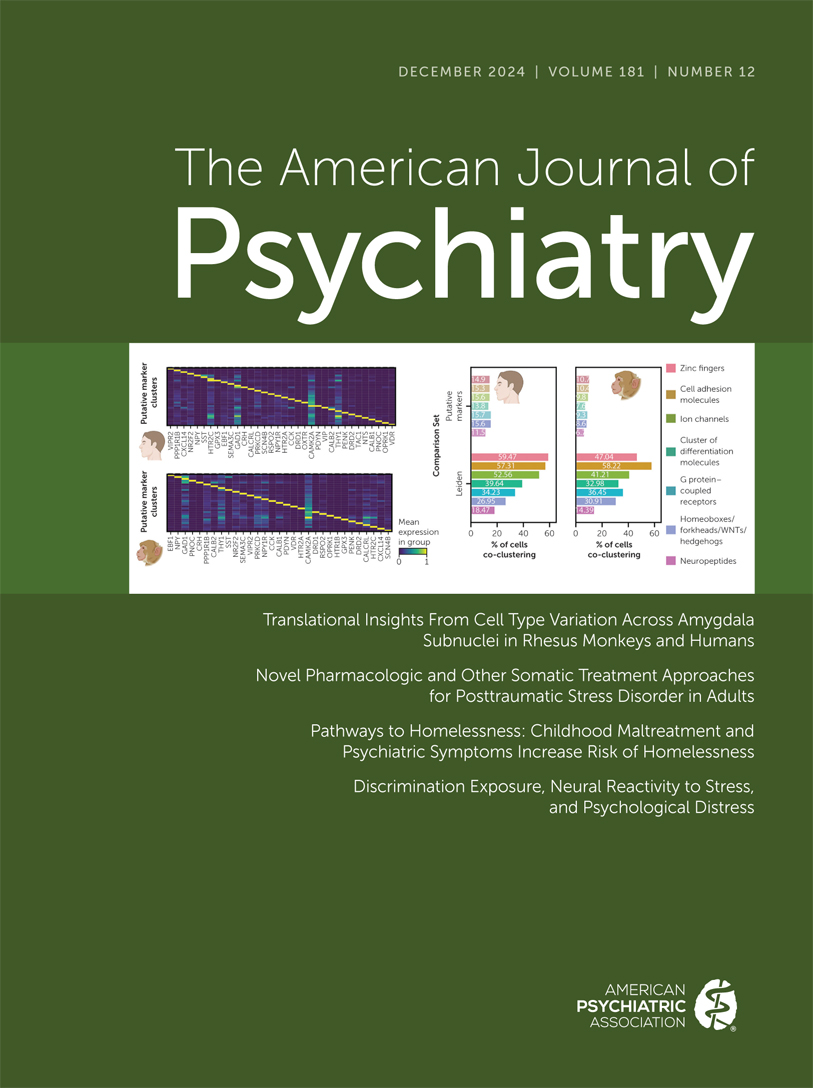American Journal of Psychiatry
- Volume 160
- Number 8
- August 2003
In This Issue
Editorial
Reviews and Overviews
Publication date: 01 August 2003
Pages1373–1384OBJECTIVE: Only in the last 30 years has psychiatry begun to develop empirical approaches to conceptualizing and assessing positive mental health. Six models of mental health are reviewed here. METHOD: The author points out pitfalls in research on mental ...
https://doi.org/10.1176/appi.ajp.160.8.1373Publication date: 01 August 2003
Pages1385–1391OBJECTIVE: In the past few decades about 1,000 controlled studies have examined the effects of mental health prevention programs, but few studies have examined the effects of such programs on the incidence of new cases of mental disorders defined ...
https://doi.org/10.1176/appi.ajp.160.8.1385Images in Neuroscience
Introspections
Images in Psychiatry
Article
Publication date: 01 August 2003
Pages1396–1404OBJECTIVE: Few long-term studies have compared the efficacy and safety of typical and atypical antipsychotic medications directly in patients with a first episode of psychosis who met the criteria for schizophrenia or a related psychotic disorder. This ...
https://doi.org/10.1176/appi.ajp.160.8.1396Publication date: 01 August 2003
Pages1405–1412OBJECTIVE: Most controlled studies comparing second-generation and conventional antipsychotics have focused on the acute treatment of schizophrenia. The authors compared symptom outcomes, side effects, and social adjustment in stable schizophrenia ...
https://doi.org/10.1176/appi.ajp.160.8.1405Publication date: 01 August 2003
Pages1413–1420OBJECTIVE: Atypical antipsychotic drug treatment is clinically effective with a low risk of extrapyramidal symptoms. Explanations for the mechanism underlying this beneficial therapeutic profile of atypical over typical antipsychotic agents include 1) ...
https://doi.org/10.1176/appi.ajp.160.8.1413Publication date: 01 August 2003
Pages1421–1427OBJECTIVE: The study was designed to assess the predictive relationship between brain structure volume and positive and negative symptom response to clozapine and haloperidol. METHOD: Partially responsive outpatients with schizophrenia who participated in ...
https://doi.org/10.1176/appi.ajp.160.8.1421Publication date: 01 August 2003
Pages1428–1431OBJECTIVE: This study characterized infant drug doses and breast-milk-to-plasma area-under-the-curve ratios for olanzapine and determined plasma concentrations and effects of this drug on breast-feeding infants. METHOD: Seven mother-infant nursing pairs ...
https://doi.org/10.1176/appi.ajp.160.8.1428Publication date: 01 August 2003
Pages1432–1438OBJECTIVE: Recently, pharmacological treatment guidelines for panic disorder have changed as newer treatment options have become available. The authors examined how the use of psychotropic drugs has shifted over the course of 10 years to determine if ...
https://doi.org/10.1176/appi.ajp.160.8.1432Publication date: 01 August 2003
Pages1439–1441OBJECTIVE: This study examined neural activation of facial stimuli in autism when the salience of emotional cues was increased by prosodic information. METHOD: Regional cerebral blood flow (rCBF) was measured while eight high-functioning men with autism ...
https://doi.org/10.1176/appi.ajp.160.8.1439Publication date: 01 August 2003
Pages1442–1452OBJECTIVE: The diagnosis of bipolar disorder in juveniles is controversial. This study was designed to compare proton magnetic resonance spectroscopy (1H MRS) in patients with bipolar disorder or intermittent explosive disorder, two groups with ...
https://doi.org/10.1176/appi.ajp.160.8.1442Publication date: 01 August 2003
Pages1453–1460OBJECTIVE: This study examined the prevalence of a history of various combinations of childhood maltreatment types (physical abuse, sexual abuse, and witnessing of maternal battering) among adult members of a health maintenance organization (HMO) and ...
https://doi.org/10.1176/appi.ajp.160.8.1453Publication date: 01 August 2003
Pages1461–1469OBJECTIVE: Many youths with conduct and substance use problems experience abuse and neglect. A valid measure of the severity of abuse-neglect events could facilitate research and clinical care. The authors’ goal was to examine the discriminative validity, ...
https://doi.org/10.1176/appi.ajp.160.8.1461Publication date: 01 August 2003
Pages1470–1478OBJECTIVE: Violence and homicide are more prevalent in Colombia, South America, than in the United States, but the role of psychosocial factors in the violent behavior of Colombian adolescents remains unclear. The objective of the study was to identify ...
https://doi.org/10.1176/appi.ajp.160.8.1470Publication date: 01 August 2003
Pages1479–1485OBJECTIVE: This study compared ratings for self-reported behavioral and emotional problems in adolescents from seven countries. METHOD: Youth Self-Report scores were analyzed for 7,137 adolescents ages 11–18 years from general population samples from ...
https://doi.org/10.1176/appi.ajp.160.8.1479Publication date: 01 August 2003
Pages1486–1493OBJECTIVE: The authors sought to determine 1) whether the risk for familial transmission of suicidal behavior is greater with increased family loading for suicide attempts, and 2) whether the transmission of suicidal behavior is mediated by impulsive ...
https://doi.org/10.1176/appi.ajp.160.8.1486Publication date: 01 August 2003
Pages1494–1500OBJECTIVE: The authors compared the characteristics of suicide attempters with and without comorbid psychiatric and personality disorders to identify factors that explain the high suicide risk associated with psychiatric comorbidity. METHOD: A ...
https://doi.org/10.1176/appi.ajp.160.8.1494Publication date: 01 August 2003
Pages1501–1508OBJECTIVE: Research on deliberate self-harm (intentionally injuring oneself without suicidal intent) has focused on clinical and forensic populations. Studying only these populations, which typically have serious psychopathology, may lead to inflated ...
https://doi.org/10.1176/appi.ajp.160.8.1501Publication date: 01 August 2003
Pages1509–1513OBJECTIVE: This study compared patients with kleptomania, patients with alcohol abuse or dependence, and psychiatric patients without impulse-control disorders or substance-related disorders on several key psychopathological dimensions. In addition, the ...
https://doi.org/10.1176/appi.ajp.160.8.1509Brief Report
Publication date: 01 August 2003
Pages1514–1516OBJECTIVE: The authors’ goal was to explore whether clozapine given as the first antipsychotic treatment favorably affects the course of schizophrenia. METHOD: Thirty-four inpatients experiencing their first episode of schizophrenia or schizoaffective ...
https://doi.org/10.1176/appi.ajp.160.8.1514Publication date: 01 August 2003
Pages1516–1518OBJECTIVE: The purpose of this study was to investigate the effect of antidepressant treatment on hippocampal volumes in patients with major depression. METHOD: For 38 female outpatients, the total time each had been in a depressive episode was divided ...
https://doi.org/10.1176/appi.ajp.160.8.1516Publication date: 01 August 2003
Pages1519–1522OBJECTIVE: The authors examined the effect of a 4-week course of estrogen therapy on depression in perimenopausal and postmenopausal women. METHOD: Twenty-two depressed women who were either perimenopausal (N=10) or postmenopausal (N=12) received open-...
https://doi.org/10.1176/appi.ajp.160.8.1519Publication date: 01 August 2003
Pages1522–1524OBJECTIVE: This study investigated the effect of estrogen on brain serotonin 2A (5-HT2A) receptors in postmenopausal women and whether there was any correlation of receptor changes with cognition and mood. METHOD: Ten postmenopausal subjects underwent ...
https://doi.org/10.1176/appi.ajp.160.8.1522Publication date: 01 August 2003
Pages1525–1526OBJECTIVE: The aim was to compare the rates of suicide in family members of suicide victims and comparison subjects who died of other causes. METHOD: The Swedish cause of death register identified all suicides in subjects born between 1949 and 1969 (N=8,...
https://doi.org/10.1176/appi.ajp.160.8.1525Publication date: 01 August 2003
Pages1527–1529OBJECTIVE: To explore the ways in which psychiatry residents conceptualize the terms “mood” and “affect,” a 14-item questionnaire was sent to residency programs in New York. METHOD: The questions consisted of possible definitions of mood and affect; all ...
https://doi.org/10.1176/appi.ajp.160.8.1527Book Forum: Psychotherapy
Book Forum: Clinical Practice
Book Forum: The Patient’s Perspective
Book Forum: Medical Psychiatry
Correction
Past Issues
View Issues Archive
Vol. 182 | No. 3

Vol. 182 | No. 2

Vol. 182 | No. 1
